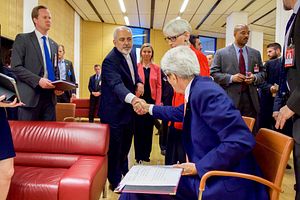I’ve read the text of the Joint Comprehensive Plan of Action (JCPOA) between Iran and the P5+1 and have one main reaction: this is a good deal, delivering or exceeding the expectations set out in early April when the P5+1 and Iran announced a framework JCPOA in Lausanne, Switzerland. Iran has committed to a wide-ranging set of concessions that will gut its nuclear program, making it unreasonably costly for it to sprint to a nuclear bomb. In exchange for its concessions, world powers, including the United States and the European Union, will lift a range of nuclear-related sanctions, helping Iran open back up for business.
Most of what’s in the document was unsurprising and in line with the U.S. fact sheet released after the Lausanne framework. What many observers of the Iran talks have been pleasantly surprised by is the sophistication of the mechanism included in the final deal that could allow the United States and its three P5+1 European allies to reinstate sanctions against Iran if Tehran is found to be violation of the terms of the agreement. Notably, this “snap back” mechanism would allow the United States to reinstate U.N. sanctions without the acquiescence of Russia and China (despite their United Nations Security Council vetoes).
I’ve affixed the verbatim text of how the sanctions “snap back” is supposed to work below this article, but the language is dense and the utility of the “snap back” mechanism isn’t easily grokked. Basically, if any of the signatories of the JCPOA have any reason to believe that another party is not upholding its commitments under the agreement–this includes Iran feeling that a P5+1 state hasn’t upheld its end of the deal regarding sanctions relief–they can refer the issue to a Joint Commission for resolution. If a non-Iran party raises an issue with the commission and isn’t too happy with the result (i.e., Iran is perceived to be in violation of the JCPOA), it can notify the UN Security Council. The Security Council has 30 days to make a move, i.e. adopt a resolution on the specific issue at hand.
Where the United States preserved unique leverage–and immunity from a Russian or Chinese veto against resuming old UN Security Council sanctions–is the next step. If the Security Council doesn’t act in 30 days, all of the pre-JCPOA nuclear-related sanctions on Iran come back into place automatically. Basically, the U.S. and the EU states in the P5+1 can veto ongoing sanctions relief but Russia and China can’t veto a return to the status quo ante. A scenario where Iran is non-compliant with the JCPOA yet escapes the old sanctions simply won’t be possible.
The innovative nature of this mechanism is a testament to the work of the nuclear negotiators who’ve been slaving away over all-nighters to produce a deal that’s not dead-on-arrival when it reaches the various national legislatures. For critics of the Obama administration’s push for this Iran deal, the ability to resume sanctions was an important consideration. It was evidence that the Iran deal wouldn’t rest on a foundation of trust, but on quid pro quo and verification. Obama said as much in his speech after the deal was announced: “This deal is not built on trust,” he emphasized.
The robust monitoring and verification requirements that Iran submitted to will be an important part of this, but it should be reassuring to critics of the deal that sanctions “snap back” is robust and essentially fool proof. With the JCPOA signed and completed, the hard part will undoubtedly implementation and I fully expect their to be disputes regarding Iran’s compliance with the terms of the deal. The deal ensures that Iran will have a compelling interest to avoid non-compliance, lest it lose everything it gained with its wide-ranging technical concessions.
Article 37 of the JCPOA, detailing the “snap back” mechanism:
37. Upon receipt of the notification from the complaining participant, as described above, including a description of the good-faith efforts the participant made to exhaust the dispute resolution process specified in this JCPOA, the UN Security Council, in accordance with its procedures, shall vote on a resolution to continue the sanctions lifting. If the resolution described above has not been adopted within 30 days of the notification, then the provisions of the old UN Security Council resolutions would be re-imposed, unless the UN Security Council decides otherwise. In such event, these provisions would not apply with retroactive effect to contracts signed between any party and Iran or Iranian individuals and entities prior to the date of application, provided that the activities contemplated under and execution of such contracts are consistent with this JCPOA and the previous and current UN Security Council resolutions. The UN Security Council, expressing its intention to prevent the reapplication of the provisions if the issue giving rise to the notification is resolved within this period, intends to take into account the views of the States involved in the issue and any opinion on the issue of the Advisory Board. Iran has stated that if sanctions are reinstated in whole or in part, Iran will treat that as grounds to cease performing its commitments under this JCPOA in whole or in part.

































